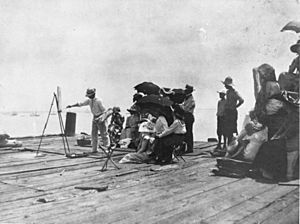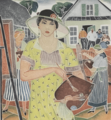Provincetown Art Association and Museum facts for kids

PAAM entrance
|
|
| Former name | Provincetown Art Association |
|---|---|
| Established | 22 August 1914 (Association) |
| Location | 460 Commercial Street, Provincetown, Massachusetts |
| Type | Art Museum |
The Provincetown Art Association and Museum (PAAM) is a special art museum in Provincetown, Massachusetts. It's like a clubhouse for artists and a place to see amazing art!
PAAM was started on August 22, 1914. Back then, it was called the Provincetown Art Association. Its main goal was to collect, save, show, and teach people about art made by artists from Cape Cod. This included artists who used different styles, like Impressionism (focusing on light and color) and Modernism (new, experimental art).
The main building at 460 Commercial Street is very old and important. It's listed on the National Register of Historic Places. In 1970, the group changed its name to Provincetown Art Association and Museum. Today, it has about 700 artists as members. PAAM's art collection has grown to more than 4,000 pieces. The museum puts on many art shows every year.
Contents
History of PAAM
How PAAM Started
Provincetown has one of the oldest summer art colonies on the East Coast. An art school opened there in 1899, started by Charles Hawthorne. On August 22, 1914, a group of artists and local business people created the Provincetown Art Association. They wanted a place for artists to share their work.
Some of the first leaders included William H. Young, Charles Hawthorne, and E. Ambrose Webster. Many other artists were also involved. For the first two years, the group met in people's homes. Later, they moved to a church for their meetings and lectures.
In the summer of 1915, the Association held its first two art shows at the Provincetown Town Hall. Artists donated their work to start the museum's collection. By this time, Provincetown had become a popular spot for artists. In 1916, it was called "The Biggest Art Colony in the World." It was known for new art styles like Impressionism and Futurism, which focused on bright colors and light.
Famous art schools in Provincetown were led by Hawthorne, George Elmer Browne, and E. Ambrose Webster. Another new art school was led by Bror Julius Olsson Nordfeldt, William Zorach, and Marguerite Zorach. There was also a group of etchers (artists who make prints) led by George Senseney. Many artists came to Provincetown in the summers, while some lived there all year.
Growing the Museum Space
PAAM became even more important when it bought land and built its own art show space. In 1919, the Association bought an old house. In 1921, they added another building next door at 460 Commercial Street. The old house was taken down, and the building at 460 Commercial Street was made into a gallery. This building is now a historic landmark. The first art show in the new space was in 1921.
More gallery space was added over the years. The Little Gallery opened in 1930, and the Hawthorne Memorial Gallery in 1942. A large gallery called the Hofmann Gallery was created in 1960. The Ross Moffett Gallery opened in 1978, and the Herman and Mary Robinson Museum School in the 1970s. By 1978, the museum also had a special storage room for its growing collection.
However, by 2001, the building was getting old and needed repairs. A big renovation and expansion project was finished in 2006. This project made the museum much better for storing and showing art. The museum's space almost doubled in size!
Today, PAAM has five galleries on the first floor that show different art exhibits all year. Three sculpture gardens are around the building. The Lillian Orlowsky and Willian Freed Museum School offers classes in drawing, painting, and printmaking. The whole building has a special system to control the temperature and humidity, which is important for protecting the art.
PAAM's building has a Silver LEED rating. This means it was designed and built to save energy and natural resources. It also won awards for its design. The old part of the museum has white cedar shingles, and the new part has special Spanish cedar shingles. This mix of old and new shows how the museum combines traditional and modern art.
Art in the 1900s
The artists who started PAAM mostly liked Impressionism. They didn't easily accept the new Modernism art style. Because of these different ideas, PAAM tried to show both types of art. Between 1927 and 1937, PAAM had separate "Modern" art shows in July and "Regular" art shows in August. The first "Modernistic Exhibition" in July 1927 included artists like Jack Tworkov and George Ault.
Eventually, modern and traditional artists found a way to show their art together. By 1939, the museum went back to having two shows each summer. They were simply called the "First" and "Second" exhibitions. PAAM also held shows for individual artists.
-
Marguerite Zorach, Annual Exhibition cover, 1922
The 1930s (during the Great Depression) and early 1940s (during World War II) were tough times for everyone, including the museum. Florence Bradshaw Brown helped lead the art association during these years. She also worked with a government program called the Works Progress Administration (WPA) to help local artists get support.
The Hawthorne Memorial Gallery was finished in 1942. It showed 12 paintings by Charles Webster Hawthorne. The museum didn't have its usual annual shows in 1942 and 1943 because of World War II. But volunteers still managed to put on some shows despite the difficulties.
By 1947, the museum was back to its regular schedule of two summer shows. New artists like Madeleine L'Engle and Adolph Gottlieb were featured. In the 1950s, a new art style called Abstract Expressionism became popular. This style had started in Provincetown with Hans Hofmann's art school in 1934.
In 1964, PAAM celebrated its 50th anniversary with a special show. This show helped people across the country see how important Provincetown was to American art. It also led to the creation of the Fine Arts Work Center, which helps artists live and work in Provincetown.
For the next 30 years, the museum continued to be both a place that collects art and a group for artists. Its collection of over 3,000 works has been used for many shows and by researchers.
PAAM Today
PAAM continues to collect both old and new art. The galleries are also used for music, dance, and spoken word performances. The new studio classrooms offer places for art classes for kids, teens, and adults at the Lillian Orlowsky William Freed Museum School.
Timeline of Art in Provincetown
| Date | Event |
|---|---|
| 1899 | Charles Hawthorne starts the Cape Cod School of Art |
| 1900 | E. Ambrose Webster starts the Summer School of Painting |
| 1914 | Provincetown Art Association is created on August 22 |
| Many artists and writers move to Provincetown from New York and Paris | |
| 1915 | The Provincetown Art Association has its first art show at the Town Hall |
| The Provincetown Printers group is formed, inspired by Japanese woodcuts | |
| 1916 | George Elmer Browne starts the West End School |
| The Modern School of Art is formed by B.J.O. Nordfeldt, William and Marguerite Zorach, and others | |
| The Beachcombers (a men's club for artists) and the Sail Loft Club (for women) are started | |
| 1921 | The 7th Annual Exhibition opens at PAAM's current location, 460 Commercial Street |
| 1927 | The First Modernist Exhibition opens, after artists asked for it |
| 1934 | Hans Hofmann School of Fine Art is established |
| 1937 | The first combined show of modern and traditional artists is held at PAAM |
| 1946 | Hans and Miz Hofmann buy a studio, and Hofmann continues teaching |
| 1949 | Kahlil Gibran, Jr., an artist, works in Provincetown |
| Forum 49 art show opens | |
| 1950s | Abstract Expressionism art style becomes very popular |
| 1959 | Many art galleries and artist groups open on Commercial Street |
| 1968 | The Fine Arts Work Center is officially created |
| 1970 | The Provincetown Art Association changes its name to Provincetown Art Association and Museum |
| 1978 | The Lower Cape Arts and Humanities group is formed |
| 1979 | The First Annual Fall Arts Festival begins |
| 1982 | The Museum School at PAAM is established |
| 1985 | Provincetown Arts Magazine is started |
| 1999 | Provincetown celebrates 100 years as an Art Colony |
| 2006 | The big renovation and expansion of PAAM is finished |
PAAM's Art Collection
PAAM's permanent collection features artists who have lived and worked on the Outer Cape. Some of the artists whose work you can find in the collection include:
- Mary Cecil Allen
- Janice Biala
- Varujan Boghosian
- Florence Bradshaw Brown
- George Elmer Browne
- Oliver Newberry Chaffee
- Carmen Cicero
- Sue Coe
- Charles Demuth
- Martha Dewing Woodward
- Edwin Dickinson
- Lynne Mapp Drexler
- Ethel Edwards
- Dorothy Eisner
- Nancy Maybin Ferguson
- Perle Fine
- Helen Frankenthaler
- Eliza Gardiner
- Jan Gelb
- Dorothy Lake Gregory
- Chaim Gross
- Mimi Gross
- Lily Harmon
- Charles Webster Hawthorne
- Marion Campbell Hawthorne
- Henry Hensche
- Hans Hofmann
- Edna Boies Hopkins
- Josephine Hopper
- Daisy Marguerite Hughes
- Lila Katzen
- Franz Kline
- Karl Knaths
- Lee Krasner
- Betty Lane
- Toni LaSelle
- Miriam Laufer
- Blanche Lazzell
- Lucy L'Engle
- Dorothy Loeb
- William H. Littlefield
- Ethel Mars
- Mildred McMillen
- Ross Moffett
- Jeannie Motherwell
- Robert Motherwell
- Seong Moy
- Mary Spencer Nay
- Lillian Orlowsky
- Anne Packard
- Jane Piper
- Ellen Ravenscroft
- Man Ray
- Mischa Richter
- John Singer Sargent
- Helen Alton Sawyer
- Shelby Shackelford
- Selina Trieff
- Jack Tworkov
- Andy Warhol
- Agnes Weinrich
- Edith Lake Wilkinson
Art Classes and Programs
The Lillian Orlowsky/William Freed Museum School at PAAM offers many classes and programs all year. In the summer (May to September), there are over seventy studio courses. These include classes in drawing, printmaking, and outdoor painting with local artists. You can also take computer classes.
PAAM offers life drawing sessions twice a week all year. During the winter, the Museum School has open print studio hours. In the fall, winter, and spring, there are longer workshops and classes. These programs are for everyone, from beginners to experienced artists.
The Museum School also has classes for children and teens. "Art Reach" is an after-school program that runs from October to May, working with Provincetown High School. PAAM also helps students create their own art shows and offers art workshops for children in the summer.
Besides classes, PAAM has free educational talks. The Fredi Schiff Levin Lecture Series runs from June to September, with other talks happening sometimes too. Artists, authors, and art historians come to speak about the history of the Provincetown Art Colony and the art scene today.
See also
- Provincetown Printers, an art group from the early 1900s


















